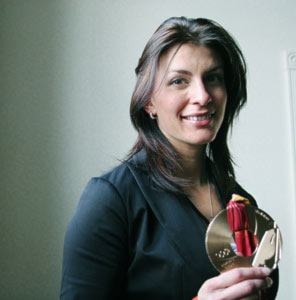After 11 years of throwing herself headfirst down icy tracks, Mellisa Hollingsworth-Richards still gets nervous at the top of a skeleton run.
“Sometimes you can be sick to your stomach wondering, ‘Am I going to make it down? Am I going to get hurt?’” said Hollingsworth-Richards.
Obviously, those worries don’t stop her.
Hollingsworth-Richards had a fantastic 2005-06 season in the sport.
She was the world cup champion, medalling in all eight races (two gold, three silver and three bronze), and she topped it off with a bronze at the Torino Olympics in February.
After her best year ever, Calgary’s Hollingsworth-Richards is spending the off-season navigating a different kind of challenge — telling her story.
“It’s definitely new to me, you’re an athlete for so long, and then, boom, you’re a public speaker,” she said Monday at the High Country Inn.
She’s in town on a motivational speaking tour for Northwestel, which has also taken her to Iqaluit and Yellowknife.
She talked to Vanier and FH Collins students on Tuesday before wrapping up the tour in Fort Nelson later this week.
Her message is pretty straightforward, all about setting goals, staying positive and believing in yourself.
“When I was in Grade 6, I was a very quiet, insecure student. My best subjects were math and science, and my worst subject was gym class,” she said.
“How do you go from being horrible in gym class to winning an Olympic medal? It’s all about having a dream.”
Her original plan was to make the women’s Olympic basketball team, but her skills were more suited to sprinting in track and field.
At 15 years old, her cousin (two-time world skeleton champion Ryan Davenport) noticed her speed and introduced her to the sport.
It’s not something you’re just thrown into.
“You have to take a school,” said Hollingsworth-Richards.
“I earned a licence by sliding halfway down the track, about 80 kilometres an hour.
“Then three-quarters, at 100 kilometres an hour, and finally from the top, where you go anywhere from 110 to 120 kilometres an hour.”
Exploding out of the gate is the key. Any advantage you can get at the start is very important — a tenth of a second at the top of the track will mean three tenths at the bottom.
“That’s why sprinters do so well,” she said.
“Once you’re on the sled, it’s finesse. You have to be extremely relaxed, which is hard, because everything’s coming at you at 120 kilometres an hour. There’s five gs in some corners, your head’s being bounced around.”
In her first season on the sled, she won the national championship, she was underage, but, luckily for her, the sport had a bit of the Wild West left in it.
“At the time it was illegal, you were supposed to be at least 16, but they kind of snuck me in,” she laughed.
She spent the next seven years competing, eventually making the world cup circuit, where she had mixed results. Her Olympic dream dominated her life.
“I put everything on the line, focused all my thoughts and energy and money on making the 2002 Olympic team — I missed it by one spot.”
Heartbroken, she thought about leaving the sport altogether. She moved to Florida for eight months before deciding give her Olympic dream another shot.
“I realized I was doing it for the wrong reasons, I wasn’t having fun anymore, wasn’t learning. I had to change that mindset going into Torino.”
A new coach, a new sponsor and a new attitude turned things around for her.
“It’s about being open to having a positive attitude, instead of thinking, ‘I’m just a middle of the road slider, and I’ll never get anywhere,’ I started believing a little bit more, and all of a sudden things started going well.”
With success, Hollingsworth-Richards started feeling the pressure, and as Torino got closer, expectations were high.
The Globe and Mail touted her as one of the country’s “sure things” for gold.
The games didn’t go the way she’d hoped.
Her final Olympic run was rough, and she sat in second place with two more competitors still to come. She figured the best she could do at that point was fourth, and she was devastated.
In the end, she managed to hang on to the bronze.
“I think it was a lesson, maybe that’s why it happened. I guess I started taking it (winning gold) for granted.
“Maybe I wouldn’t have appreciated the gold as much as I appreciated this bronze.”
With three of the five sliders on Canada’s team coming home with medals, (Duff Gibson, men’s gold, Jeff Pain, silver, and Hollingsworth-Richards, women’s bronze) and another just missing the podium (Paul Boehm, fourth by .02 of a second), Canada’s skeleton crew is strong all-around.
Hollingsworth-Richards credits the legacy of the 1988 Calgary Olympics, and the facilities there, for the team’s success.
Not content to rest on her laurels, Hollingsworth-Richards is already thinking about 2010.
“With Vancouver in our backyard in four years, we’re working hard, experimenting with new training regimes, trying to improve.
“A lot of people might take this year off, but we’re doing a lot.”
